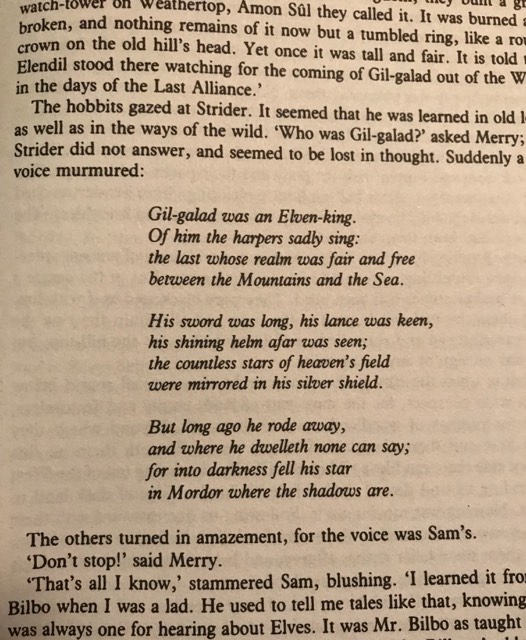Intra-Series Poetry – Poetry Alongside Other Mediums

If you read my first piece about Poetry in the Tech era, you may have caught that I first experienced poetry when it droned out the low humming of my family’s Ford Taurus. I eventually wore out the cassette tapes (and my parents’ ears—you really can only hear Peanut-Butter Sandwich like 20 times before you want to pull your hair out) and made the transition to longer works of fiction—although back in the 90s, books-on-tape could be hard to find, so instead my mother read whole books to my sister and I on those long summer car rides.
Fewer of those memories have survived the two decades of school than I would have liked, but my first experience with the Artemis Fowl series and parts one and two of The Lord of the Rings have held on in bits and pieces. Even at 5 or 6 (or 8? I was little, ok?), I noticed the little insertions of poetry. Not poetry like Ulysses in Skyfall, but original pieces of lore, written explicitly to expand each world. Those pieces made the magic of the story real—as though I was hearing a real wizardly incantation, rather than imaginary enchantments printed on the flesh of dead trees. As stand-alone pieces, these poems lose meaning, but alongside the mythos created by their authors, they can connect with fans at a core level—take this example by Stephen Colbert on Rolling Stones.

These poems, which I am calling “intra-series” poems seem to get little attention in the poetry world, despite capturing the attention of the masses. I’m not saying that these poems are perfect, or even near the “standard,” but dang does that line “Not all those who wander are lost” hit different when it’s read as Frodo decides whether or not to trust Strider. These intra-series poems are able to overcome the obstacle of connecting to otherwise uninterested people because the authors of the poems have used another medium to reach their readers before introducing them to the unfamiliar material. I love poetry, but I still sometimes find it hard to feel invested in an unnamed narrator of some Shakespearean sonnet, or a dangling square on a page in the New Yorker. But hearing the prophecy that Aragorn would one day reclaim his crown in a letter from Gandalf, just so that Frodo will trust him? That blew my mind as a kid.
Poetry shaping and being shaped by other mediums is more than just an aspect of Tolkien though. Marvel references Norse mythology. T.S. Eliot references Shakespeare. Dante references Virgil. Unlike these though, Tolkien, and other expansive stories use intra-media references to help build themes within a story. Take Dr. Who as an example. Whovians are obsessed with the web of Time Lord lore, and the writers use this in conjunction with their complex plotline in order to get an audience to really “hear” their poetry. See: Series (season) 6, Episode 7, where Steven Moffat interweaves a prophecy about the Doctor going to war. Now, I don’t think this is a particularly “good” poem, but it emphasizes the trauma that the Doctor has experienced leading up to this moment while simultaneously creating curiosity within the viewer about how the series will continue to unravel. Viewers get to ponder how moments in future episodes pertain to this prophecy, and the implications therein create tension. As a result, viewers perceive this poem as central to the series, and (in their own way) experience the Muse that we feel whenever we read our favorite poet.

Now, I’m not saying that intra-series works are the future of poetry. My Papa’s Waltz may not have touched my heart if it had been nestled within some massive saga. I’m just saying that these writers have succeeded in grabbing the attention of their fans by creating a symbiotic relationship between poetry and other mediums of entertainment—and that’s something we should celebrate more, because that is what is keeping poetry alive in the hearts of those who don’t seek it out.
– Cassady O’Reilly-Hahn
______________________________________________________________________
A Moment of Zen:
Cat Painting
A rogue pair of paws
step into the batch of blue
and cross the canvas.

Share